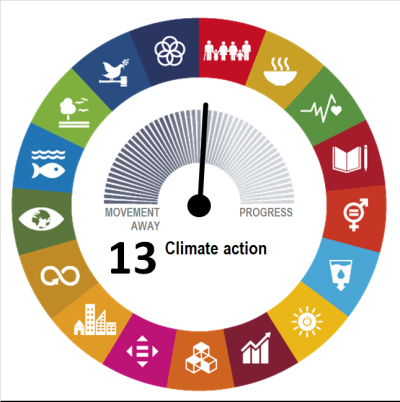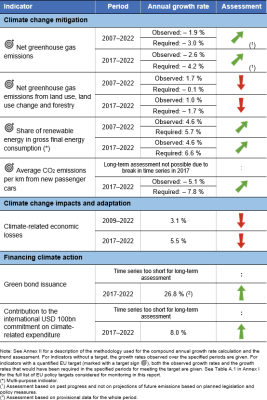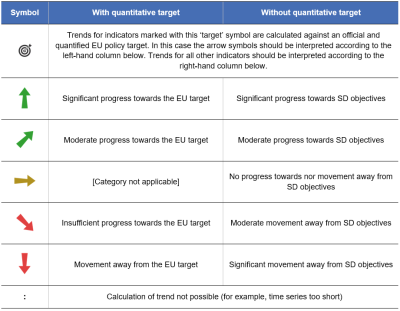SDG 13 - Climate action
Take urgent action to combat climate change and its impacts
Data extracted in April 2024.
Planned article update: June 2025.
Highlights
This article is a part of a set of statistical articles, which are based on the Eurostat publication ’Sustainable development in the European Union — Monitoring report on progress towards the SDGs in an EU context — 2024 edition’. This report is the eighth edition of Eurostat’s series of monitoring reports on sustainable development, which provide a quantitative assessment of progress of the EU towards the SDGs in an EU context.
SDG 13 seeks to achieve a climate-neutral world by mid-century and to limit global warming to well below 2°C — with an aim of 1.5°C — compared with pre-industrial times. It aims to strengthen countries’ climate resilience and adaptive capacity, with a special focus on supporting least-developed countries.
Full article
Climate action in the EU: overview and key trends
Climate change increases global air and ocean temperatures, changes precipitation patterns, raises the global average sea level, provokes extreme weather events, harms biodiversity and increases ocean acidity. Its impacts threaten the viability of social, environmental and economic systems and may make some regions less habitable due to food and water scarcity. Monitoring SDG 13 in an EU context focuses on climate mitigation, climate impacts and adaptation, and financing climate action. As surface temperatures rise, the EU continues to face intensifying climate impacts and economic losses from climate-related events, which have increased in recent years. Net greenhouse gas (GHG) emissions kept falling when excluding the remarkable drop in 2020 following the COVID-19 pandemic. However, more efforts will still be needed to reach the target of reducing net GHG emissions by at least 55 % by 2030 compared with 1990 — efforts that are reinforced by the ‘Fit for 55’ package. The 2030 target includes net GHG removals from land use, land use change and forestry, which have declined since 2013. The share of renewables has kept rising in the EU, but stronger progress will be needed to meet the new 2030 target. Financing of the transition saw new funds made available via the issuance of green bonds from cooperatives but also governmental issuers. Climate finance kept progressing, with climate-related expenditure for developing countries increasing further.
Climate change mitigation
Climate mitigation aims to reduce emissions of climate-harming greenhouse gases (GHG) that originate from human activity through measures such as promoting low-carbon technologies and practices or encouraging sustainable forest management and land use that enhance carbon removals. The EU has set into law the target to reach climate neutrality with no net GHG emissions by 2050. This means reducing GHG emissions as much as possible while compensating for the residual and unavoidable emissions by removing carbon dioxide (CO2), for example through natural carbon sinks and by using carbon-removal technologies. As an intermediate target on the path to climate neutrality in 2050, the EU has committed itself to reducing net GHG emissions by at least 55 % by 2030 compared with 1990 levels. In February 2024, the European Commission issued a Communication on the EU’s 2040 climate target, with a recommendation for a net reduction of emissions of 90 % relative to 1990 levels, launching a debate with stakeholders.
GHG emissions continue to fall compared with pre-pandemic levels, with more to be done to meet the 2030 target
Between 1990 and 2022, the EU achieved a 31.0 % reduction in its net GHG emissions, which include net removals from land use and forestry. This means that over the next eight years, emissions will need to fall much quicker for the EU to reach its net GHG emission reduction target of 55 % by 2030.
A large proportion of the EU’s emission reductions since 1990 have occurred between 2007 and 2022, with net emissions falling by 24.5 % during this period. The short-term trend shows a rather steady decrease when excluding the year 2020. The remarkable 10.6 % drop in that year can mainly be attributed to the measures taken in response to the COVID-19 pandemic and the related reduction in energy consumption. Overall, EU net emissions fell by 12.3 % between 2017 and 2022.
Per capita emissions have fallen in line with the overall reduction in net GHG emissions
Across the EU, net GHG emissions per capita ranged from 0.6 tonnes of CO2-equivalent in Sweden to 14.5 tonnes in Luxembourg in 2022. The high value of Luxembourg can be partly attributed to a relatively large number of commuters and transit traffic [1]. Between 2017 and 2022, net GHG emissions per capita fell in all Member States except for Bulgaria, Latvia and Finland. While per capita emissions grew only slowly in Bulgaria and Finland, by 4.2 % and 2.2 %, respectively, Latvia reported a 93.0 % increase, mainly as a result of growing emissions from land use and forestry. The strongest reductions over the period from 2017 to 2022 were reported by Portugal, Sweden and Estonia, with net GHG emissions per capita falling by 43.6 %, 40.0 % and 37.8 %, respectively.
Carbon removals remain on a downward trend
Net GHG removals come from land use and forestry, which is also referred to as the ‘land use, land use change and forestry (LULUCF)’ sector according to the Intergovernmental Panel on Climate Change (IPCC) classification. Within this sector, forests remove CO2 from the air (as trees capture CO2 through photosynthesis), which in most Member States overcompensates for emissions from land use (for example, from the use of fertilisers) and land use change (for example, when grassland is converted to cropland).
Between 2007 and 2022, GHG net removals from land use and forestry fell by 22.2 % in the EU. The decline in forest carbon sinks has been attributed to several trends, including slowdowns in net afforestation and in forest biomass growth as well as increases in tree mortality and in timber harvesting [2]. In the short-term period between 2017 and 2022, the EU’s net removals from land use and forestry declined further, by 4.8 %. Due to the reductions in total GHG emissions, net removals still compensated for 6.8 % of emissions in 2022. In absolute numbers, net removals amounted to 236.4 million tonnes (Mt) of CO2-equivalent in 2022. This is well below the EU’s net carbon removal target for land use and forestry of at least 310 Mt of CO2-equivalent by 2030.
Emissions associated with energy consumption have fallen thanks to reduced energy consumption and increased use of renewables
A sectoral breakdown of the GHG emissions for 2022 shows that two sectors — energy industries (which covers electricity and central heat generation) and transport (including international aviation) — were responsible for more than half of total EU emissions, with each of these sectors accounting for around 26 % of emissions. Industry and other energy consumers were the third and fourth largest emitters of GHGs in the EU, accounting for around 20 % and 14 % of total emissions in 2022, respectively. Between 2017 and 2022, energy industries showed the strongest reduction in emissions, of around 20 %. Emissions from industry and from other energy consumers fell by around 13 % each, while transport emissions dropped by less than 4 % over the same period [3].
Emissions arise mainly from fossil energy consumption, whereby related reductions result from the general drop in energy consumption and an increasing share of renewable energies (see the article on SDG 7 ‘Affordable and clean energy’). In total, renewable energy contributed 23.0 % of the EU’s gross final energy consumption in 2022. While this was an increase of 4.6 percentage points between 2017 and 2022, stronger progress is vital to reach a 42.5 % share of renewable sources in energy consumption by 2030. A sectoral breakdown shows that the share of renewables was largest in electricity generation, reaching 41.2 % in 2022. The shares of renewables in heating and cooling and in transport were lower, at 24.9 % and 9.6 % in 2022, respectively.
Average CO2 emissions per km from new car fleets have fallen since 2017
Road transport was responsible for almost a quarter of the EU’s total GHG emissions in 2022, and more than half of road transport emissions came from passenger cars [4]. To reduce those emissions, the EU has set targets for the fleet-wide average CO2 emissions of new passenger cars and vans, and heavy duty vehicles. For each manufacturer’s new fleet, a binding specific emission target has been set so that the overall target for the EU’s average fleet emissions will be met. For cars and vans, this manufacturer’s target is based on the average mass of its new cars or vans and for lorries the target is based on mileage and payload. The EU fleet-wide targets for average CO2 emissions per kilometre (km) from new passenger cars and vans have been set to 93.6 grams per km (g/km) for 2025 and to 49.5 g/km for 2030, while from 2035 onwards all new cars and vans registered in the EU must be zero-emission vehicles[5].
Over the period 2017 to 2022, the average CO2 emissions per km from new passenger cars registered in the EU fell by 23.2 %, with most of this reduction taking place between 2019 and 2021. The EU average CO2 emissions reached 109.8 g/km in 2022, which is still far from the respective EU targets for 2025 and 2030.
Accelerating the market uptake of new zero emission vehicles is a crucial step to achieving the CO2 emission targets for new vehicles. The share of zero-emission passenger cars (including battery and fuel cell electric as well as hydrogen cars) in newly registered cars in the EU rose from 0.7 % in 2017 to 12.1 % in 2022. However, the share differs considerably between countries. Sweden reported the highest share with 32.9 % in 2022, followed by the Netherlands with 23.5 % and Denmark with 20.6 %. In contrast, zero-emission vehicles only accounted for around 2 % of newly registered passenger cars in Czechia and Slovakia [6].
Climate change impacts and adaptation
Rising concentrations of CO2 emissions and other GHGs lead to global warming and increased ocean acidity. As a consequence of global anthropogenic GHG emissions, the decade 2013 to 2022 was the warmest on record, with a global mean near-surface temperature increase of 1.13–1.17 °C compared with the pre-industrial level. This means that more than half of the warming towards the global 2 °C limit stipulated in the Paris Agreement has already occurred. The average annual temperature over the European continent has increased even more, by 2.04–2.10 °C during this decade [7].
Climate impacts are a consequence of rising temperatures and the related intensity and quantity of extreme events which affect environmental, social and economic systems. The EU’s SDG monitoring focuses on the economic costs that arise from weather- and climate-related extreme events. To minimise the impacts, countries are taking action to adapt to climate change by introducing measures such as flood protection, adapted agricultural practices and forest management, and sustainable urban drainage systems. However, adaptation is lagging far behind the impacts.
Economic losses from weather- and climate-related extreme events have been considerable in recent decades
Studies have shown that various weather- and climate-related extreme events in Europe and beyond have become more severe and frequent as a result of global climate change. The resulting impact on human systems and ecosystems has led to measurable losses to nature, economies and people’s livelihoods [8]. Reported economic losses generally reflect monetised direct damages to certain assets and as such are only partial estimates of the full damages. They do not consider losses related to productivity, mortality and health, cultural heritage or ecosystems services, which would considerably raise the estimate [9].
Over the period 1980 to 2022, weather- and climate-related losses accounted for a total of EUR 650 billion [10]. 2022 marked another negative record with climate-related economic losses amounting to EUR 52.3 billion, most of which (EUR 40.9 billion) was caused by climatological events such as heat or cold waves, droughts and forest fires. This is only slightly below the 2021 loss of EUR 59.4 billion, which was caused mainly by hydrological events such as floods.
However, recorded losses vary substantially over time: about 59 % of the total losses have been caused by just 5 % of unique extreme events [11]. This variability makes the analysis of historical trends difficult. However, a closer look at a 30-year moving average shows an almost steady increase in annual climate-related economic losses, from EUR 11.9 billion in 2009 to EUR 17.7 billion in 2022 [12], which corresponds to a 48.0 % increase. The three most expensive climate extreme events during the period from 1980 to 2022 included the 2021 flooding in Germany and Belgium (EUR 44 billion), the 2022 drought (EUR 40 billion), and the 2002 flood in central Europe (EUR 34 billion), all at 2022 prices [13].
Financing climate action
As part of the transition towards climate neutrality and climate resilience, the EU is endeavouring to redirect public and private investments to areas where they will support this objective. For this reason, the EU has adopted the EU taxonomy as a classification system for sustainable economic activities and a European green bond standard as a voluntary ‘gold’ standard for the green bond market. At EU level, climate change mitigation and adaptation has been integrated into all major spending programmes [14] and the EU has also committed to support international climate action.
Green bond issuance has been increasing significantly, leaving behind its existence as a niche product
Investments into clean technologies and supportive infrastructure are key for the transition to climate neutrality. Such investments often rely on funds which can be raised for example through the issuance of bonds. There are different issuers active in the green bond market such as the EU, which issues for example the NextGenerationEU Green Bonds to finance climate action in the EU.
Provisional data on the share of green bonds in total bonds issuance indicate an increase from 2.7 % to 8.9 % between 2017 and 2022. This suggests that green bonds are moving away from being a niche product. Supranational issuers and cooperates particularly increased the share of green bonds, so that green bonds made up 8.6 % and 11.0 % of their respective total bond issuance. The importance of green bonds is likely to continue to grow as investors place increasing emphasis on the sustainability of their investments and consistency with policy objectives [15].
The EU’s contribution to climate finance for developing countries has been increasing since 2014
In addition to investing in climate action within its borders, the EU and its Member States have also committed to raising money to combat climate change and for adapting to climate impacts in developing countries. They take part in a commitment made by the world’s developed countries to jointly mobilise USD 100 billion per year by 2025, from a wide variety of sources, instruments and channels [16].
Total EU public finance contributions (including all 27 Member States as well as the EU institutions) increased from about EUR 12.9 billion in 2014 to EUR 28.5 billion in 2022. This equals roughly USD 30 billion contribution to the global target. The two largest contributors in the period were Germany and France. The European Commission and the European Investment Bank (EIB) were the third and fourth largest donors in 2022, respectively. In 2020, the EU, its Member States and the EIB together were the biggest contributors of public climate finance to developing countries worldwide [17]. It is important to note that due to methodological changes, data from 2020 onwards are not fully comparable with earlier years. The data for 2020 and 2021 cover commitments for both multilateral and bilateral public finance. Data for 2022 cover bilateral finance committed and multilateral finance provided.
Main indicators
Net greenhouse gas emissions
This indicator measures man-made greenhouse gas (GHG) emissions as well as carbon removals on EU territory. The ‘Kyoto basket’ of GHGs includes carbon dioxide (CO2), methane (CH4), nitrous oxide (N2O) and the so-called F-gases F-gases, i.e., hydrofluorocarbons, perfluorocarbons, nitrogen trifluoride (NF3) and sulphur hexafluoride (SF6). Emissions and removals are integrated into a single indicator — net GHG emissions — expressed in units of CO2 equivalents based on the global warming potential (GWP) of each gas. At present, carbon removals are accounted for only in the land use, land use change and forestry (LULUCF) sector. The net GHG emissions shown here include international aviation, indirect CO2 and natural carbon removals from LULUCF. The indicator refers to GHG emissions in the EU territory. GHG emissions derived from the production of goods imported and consumed in the EU are counted in the export country, following the United Nations Framework Convention on Climate Change (UNFCCC) rules. Emissions and removals data, known as GHG inventories, are submitted annually by Member States to the EU and the UNFCCC. The European Environment Agency (EEA) compiles the EU aggregate data and publishes data for the EU and all Member States. Eurostat republishes the EEA data.
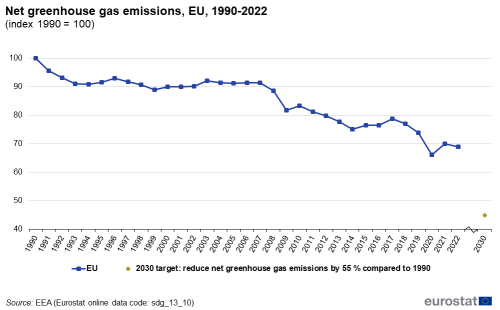
Note: y-axis does not start at 0.
Source: EEA, Eurostat (sdg_13_10)
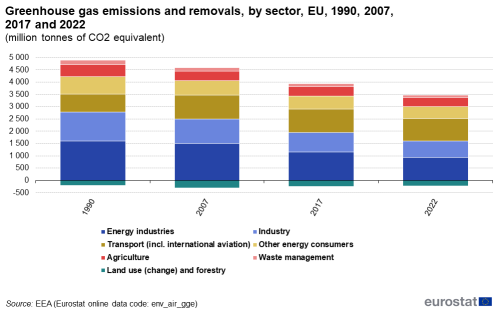
Source: EEA, Eurostat (env_air_gge)
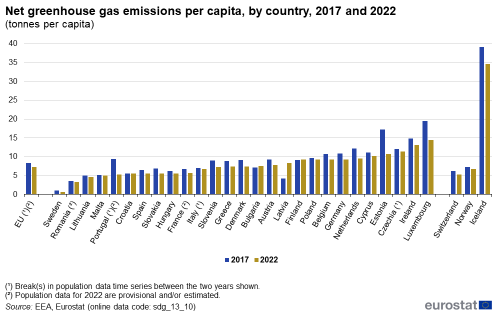
Source: EEA, Eurostat (sdg_13_10)
Net greenhouse gas emissions from land use, land use change and forestry
This indicator measures net carbon removals from the land use, land use change and forestry (LULUCF) sector, considering both emissions and removals from the sector. The indicator is expressed as CO2 equivalents using the global warming potential (GWP) of each gas. Emissions and removals data, known as greenhouse gas (GHG) inventories, are submitted annually by Member States to the EU and the United Nations Framework Convention on Climate Change (UNFCCC). The European Environment Agency (EEA) compiles the EU aggregate data and publishes data for the EU and all Member States. Eurostat republishes the EEA data.
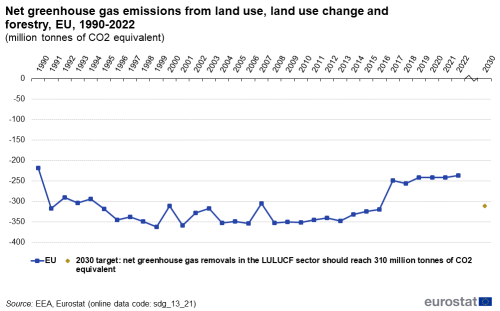
Source: EEA, Eurostat (sdg_13_21)
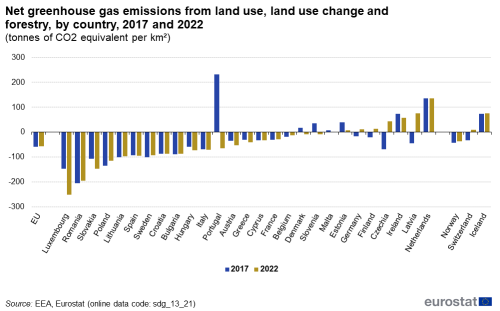
Source: EEA, Eurostat (sdg_13_21)
Average CO2 emissions per km from new passenger cars
This indicator is defined as the average carbon dioxide (CO2) emissions per km from new passenger cars registered in a given year. The reported emissions are based on type-approval and can deviate from the actual CO2 emissions of new cars on the road. Data up to (and including) 2019 were collected according to the New European Driving Cycle (NEDC) procedure, while the data collection from 2021 onwards is based on the World Harmonised Light-vehicle Test Procedure (WLTP). Data for 2020 were collected based on both protocols. For the purpose of monitoring progress in this report, data for 2017 to 2019 are presented according to WLTP based on a conversion factor calculated using 2020 data in NEDC and WLTP, while data before 2017 are presented according to NEDC. Data presented in this section are provided by the European Commission, Directorate-General for Climate Action and the European Environment Agency (EEA).
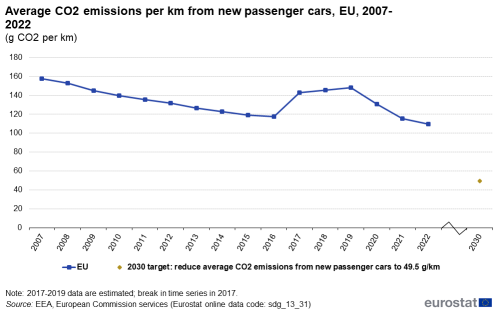
Source: EEA, European Commission services, Eurostat (sdg_13_31)
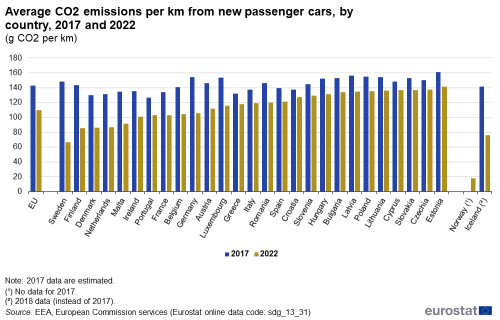
Source: EEA, European Commission services, Eurostat (sdg_13_31)
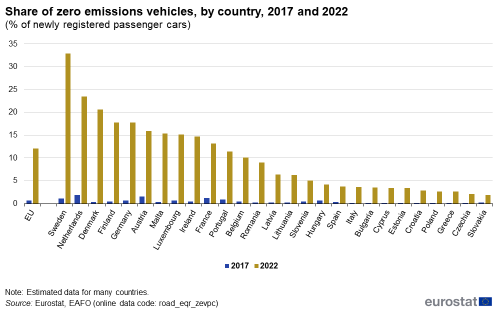
Source: Eurostat, EAFO (road_eqr_zevpc)
This indicator includes the overall monetary losses from weather- and climate-related events. The European Environment Agency (EEA) compiles the EU aggregate data from CATDAT of RiskLayer. Eurostat republishes the EEA data. Due to the variability of the annual figures, the data are also presented as a 30-year moving average to facilitate the analysis of historical trends.
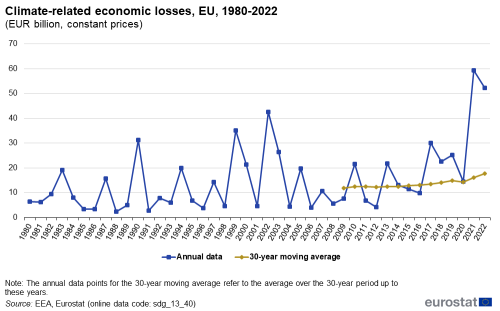
Source: EEA, Eurostat (sdg_13_40)
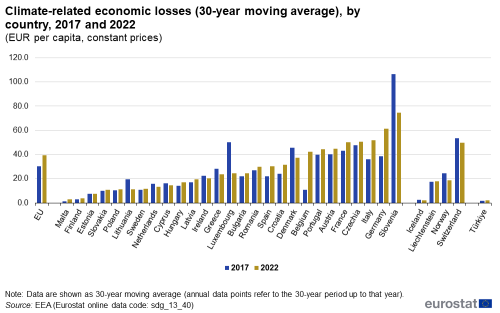
Source: EEA, Eurostat (sdg_13_40)
Green bond issuance
Green bonds are loans provided by an investor to a borrower which are used to fund projects or activities that promote climate change mitigation or adaptation or other environmental objectives. While the green bond definition can vary, this indicator includes bonds that are aligned with the four core components of the International Capital Market Association (ICMA) green bond principles or are certified by the Climate Bond Initiative (CBI) [18]. Issuers include the supranational issuers such as the EU or the EIB, subnational issuers such as municipalities or agencies, cooperates such as a company or financial corporation, and sovereign bond issuers which are national governments.
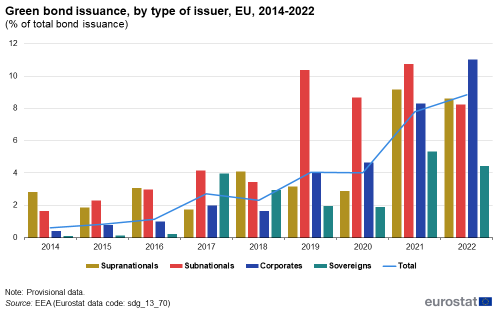
Source: EEA (sdg_13_70)
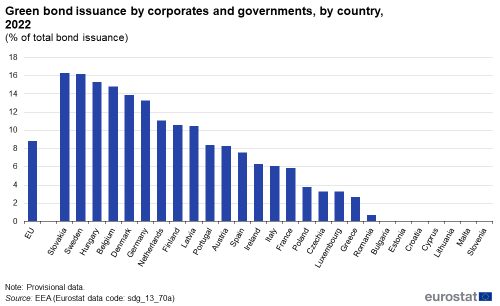
Source: EEA (sdg_13_70a)
The intention of the international commitment on climate finance under the United Nations Framework Convention on Climate Change (UNFCCC) is to enable and support enhanced action by developing countries to advance low-emission and climate-resilient development. The data presented in this section are reported to the European Commission under the Monitoring Mechanism Regulation (Regulation (EU) 525/2013) for the period up to 2019 and under the Governance Regulation (Regulation (EU) 2018/1999) for subsequent years. The data refer to public finance only and do not include private finance.
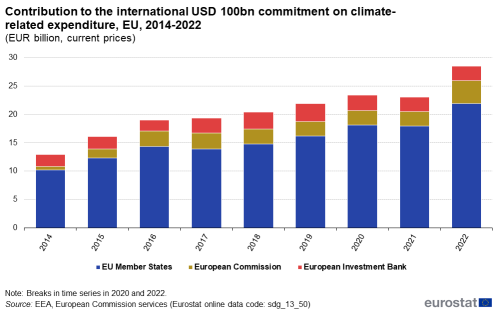
Source: EEA, European Commission services (sdg_13_50)
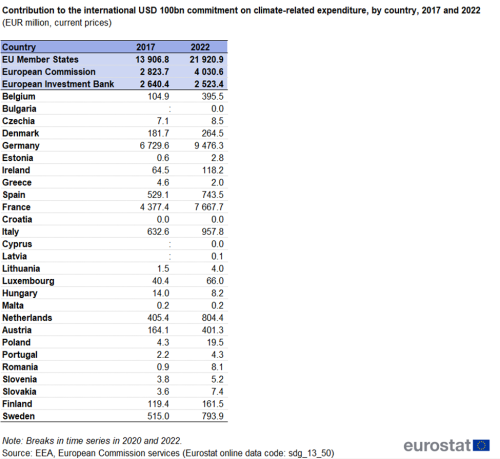
Source: EEA, European Commission services (sdg_13_50)
Direct access to
More detailed information on EU SDG indicators for monitoring of progress towards the UN Sustainable Development Goals (SDGs), such as indicator relevance, definitions, methodological notes, background and potential linkages can be found in the introduction as well as in Annex II of the publication ’Sustainable development in the European Union — Monitoring report on progress towards the SDGs in an EU context — 2024 edition’.
Further reading on climate action
- European Commission, Climate Action.
- European Commission, Citizen support for climate action.
- European Commission, International Climate Finance.
- European Commission (2020), Kick-starting the journey towards a climate-neutral Europe by 2050 — EU Climate Action Progress Report.
- European Commission, Climate Action – 2050 long-term strategy.
- EEA (2023), Trends and projections in Europe 2023, EEA Report No. 07/2023, European Environment Agency, Copenhagen.
- EEA (2018), National climate change vulnerability and risk assessments in Europe, 2018, European Environment Agency, Copenhagen.
- EEA (2020), Urban adaptation in Europe: how cities and towns respond to climate change, EEA Report No 12/2020.
- IPCC (2022), Summary for Policymakers. In: Climate Change 2022: Impacts, Adaptation, and Vulnerability. Contribution of Working Group II to the Sixth Assessment Report of the Intergovernmental Panel on Climate Change. Cambridge University Press, Cambridge, UK and New York, NY, USA.
Further data sources on climate action
- EEA, Greenhouse gas data viewer.
- EEA, EEA greenhouse gas projections — data viewer.
- EEA, EEA database on integrated national climate and energy policies and measures in Europe.
- Global and European temperatures.
- Eurostat, Climate change.
- Eurostat, Statistics Explained: Climate change — Driving forces.
Notes
- ↑ Luxembourg (2023), Eighth National Communication of Luxembourg under the United Nations Framework Convention on Climate Change.
- ↑ See for example: ESABCC (2024), Towards EU climate neutrality—Progress, policy gaps and opportunities, European Scientific Advisory Board on Climate Change; and Hyyrynen, M., Ollikainen, M., & Seppälä, J. (2023), European forest sinks and climate targets: Past trends, main drivers, and future forecasts, European Journal of Forest Research, 142(5), 1207–1224.
- ↑ Eurostat (online data code: (env_air_gge))
- ↑ Eurostat (online data code: (env_air_gge))
- ↑ European Commission (2023), Commission Implementing Decision (EU) 2023/1623 of 3 August 2023 specifying the values relating to the performance of manufacturers and pools of manufacturers of new passenger cars and new light commercial vehicles for the calendar year 2021 and the values to be used for the calculation of the specific emission targets from 2025 onwards.
- ↑ Source: Eurostat and European Alternative Fuels Observatory (online data code: (road_eqr_zevpc))
- ↑ European Environment Agency (2023), Global and European temperatures.
- ↑ IPCC (2023), Climate change 2023 – Synthesis Report – Summary for Policymakers, Contribution of Working Groups I, II and III to the Sixth Assessment Report of the Intergovernmental Panel on Climate Change [Core Writing Team, H. Lee and J. Romero (eds.)]. IPCC, Geneva, Switzerland, pp. 1-34.
- ↑ IPBES (2019), Summary for policymakers of the global assessment report on biodiversity and ecosystem services of the Intergovernmental Science-Policy Platform on Biodiversity and Ecosystem Services, Bonn; and European Environment Agency (2016), Climate change impacts and vulnerability in Europe: An indicator-based report, Report No. 1/2017, Copenhagen.
- ↑ European Environment Agency (2023), Economic losses from climate-related extremes in Europe (temporal coverage 1980–2022).
- ↑ Ibid.
- ↑ A 30-year moving average shows the average over the past 30 years for a given year. For example, for 2017, the data point shows the average from 1988 to 2017.
- ↑ European Environment Agency (2023), Economic losses from climate-related extremes in Europe (temporal coverage 1980–2022).
- ↑ European Commission, The EU long-term budget.
- ↑ See also EEA (2023), Green bonds.
- ↑ European Commission (2018), A modern budget for a Union that protects, empowers and defends: The Multiannual Financial Framework for 2021–2027, COM(2018) 321 final, Brussels.
- ↑ European Commission (2022), International climate finance.
- ↑ EEA (2023), Green bonds.
